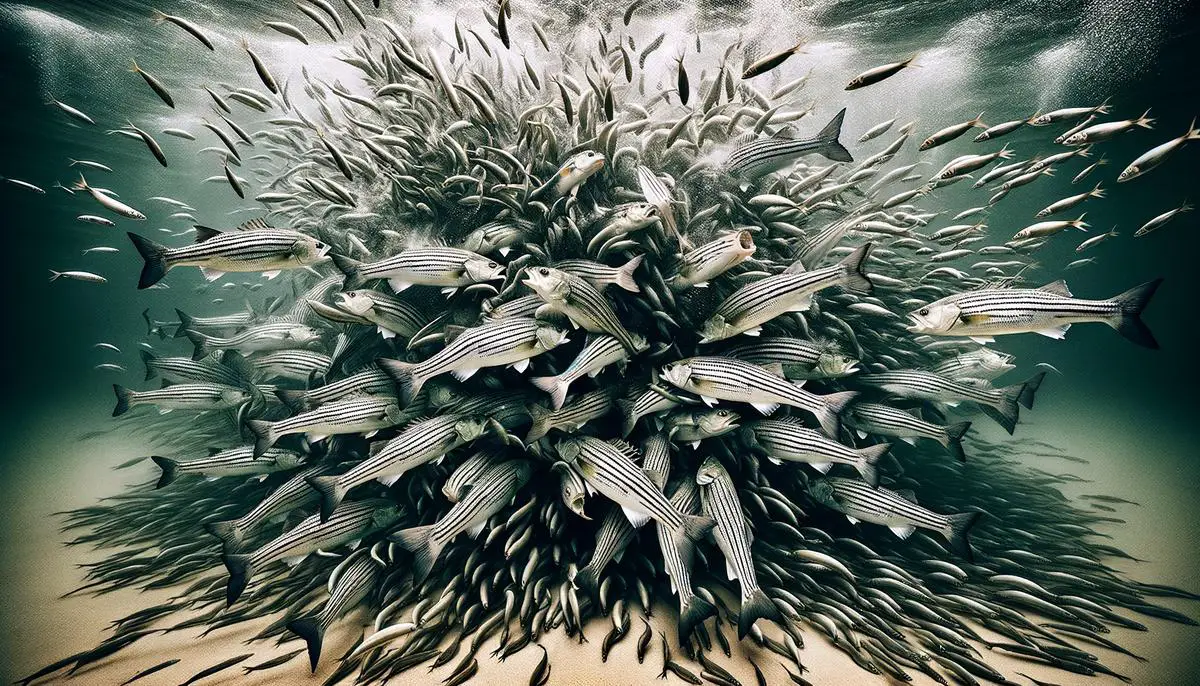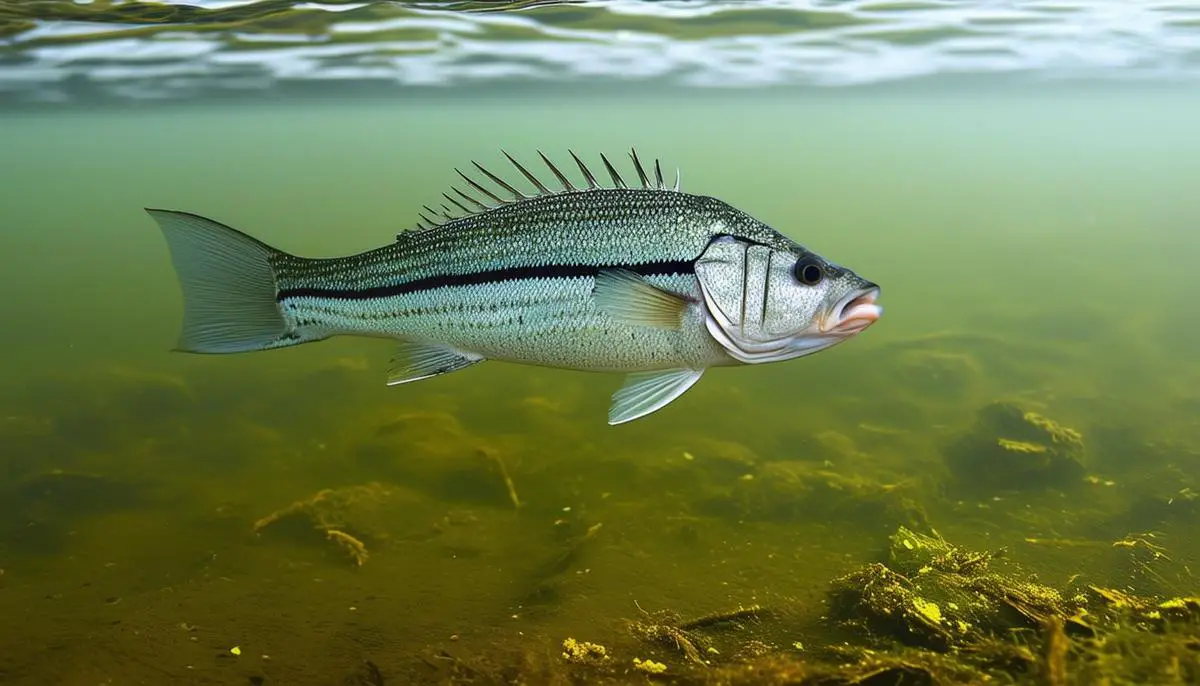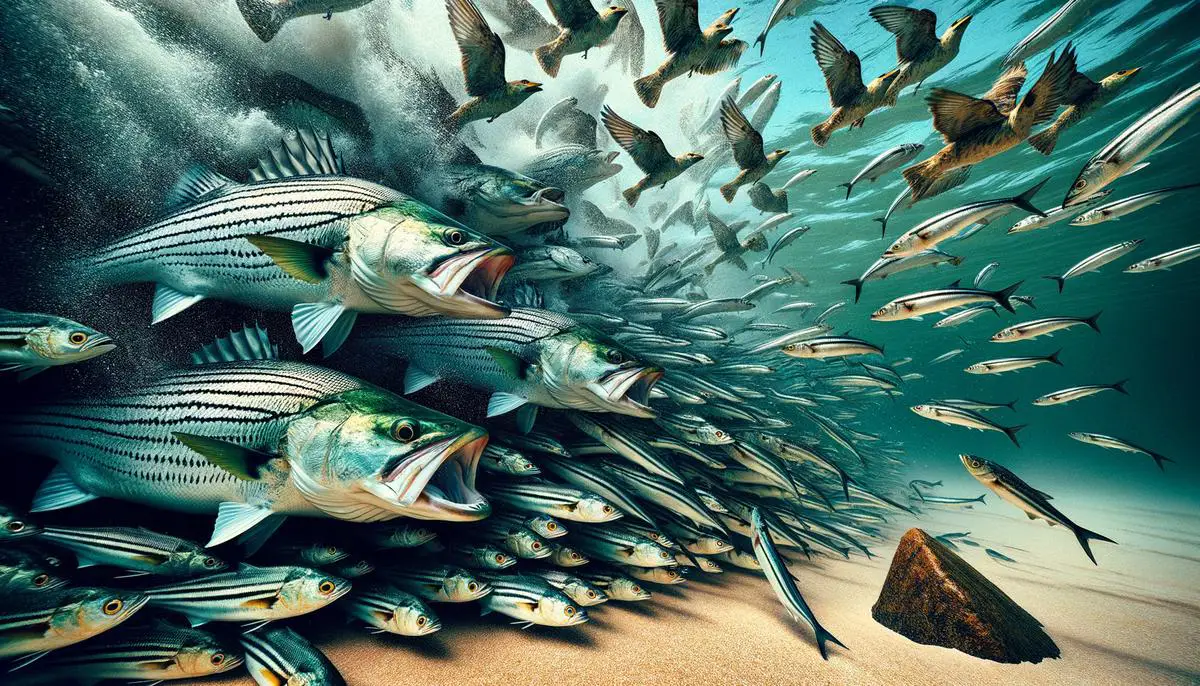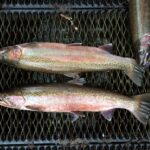Ideal Water Temperatures for Striped Bass
Striped bass thrive in water temperatures ranging from 48 to 62.5 degrees Fahrenheit. Within this range, their feeding activity varies significantly. When water temperatures hit 48 degrees, usually around early spring, the bass awaken from their winter dormancy and begin searching for food. Their feeding activity intensifies as water temperatures rise between 48 and 58 degrees, often leading to strong feeding frenzies, particularly when there is an abundance of bait like sand eels and mackerel.
During this period, bass tend to increase their feeding activity, especially near or on the water surface. Fishermen have observed striped bass schools in Cape Cod's shallow flats, chasing baby sand eels in less than three feet of water. The arrival of mackerel also significantly boosts the activity levels of striped bass, with reports of catches exceeding 40 inches during these times.
Around the low 60s, striped bass enter their spawning mode, particularly prevalent in rivers like the Hudson and Susquehanna. The best catches often occur right before spawning, as the bass prepare for this critical period. After spawning, they move back to the bays and estuaries until the water temperatures rise above 68 degrees Fahrenheit, prompting another migration.
Temperature fluctuations greatly influence striped bass locations. During cooler periods in spring (low to mid-50s), the bass are generally found closer to shorelines, channel edges, and shallow bays, where they prey on grass shrimp, crabs, and small baitfish. In contrast, higher temperatures push them offshore in search of cooler, more oxygen-rich waters.
Fishermen targeting early-season stripers rely heavily on real-time water temperature data, with websites providing updated readings proving invaluable. Observing cues from nature, such as blooming dogwoods and cherry trees, which align with optimal fishing temperatures, can also be helpful.
Water temperatures also dictate bait preferences. For instance, Greg Cudnik emphasizes the importance of slightly warmer outflows from creeks and sun-warmed shallow sod banks when targeting early-season bass. Artificial lures like soft plastics, Fin-S Fish, and Keitech paddletails are effective, especially when fished slowly in cooler waters.
In New Jersey, where striped bass fishing season opens on March 1, strategies vary depending on the location and techniques honed over years of fishing. Targeting shallower areas warmed by the sun's rays or areas with a slight wind direction that pushes the baitfish towards the bass can lead to more successful catches.
As spring progresses, fishermen use various lures like Keitech Swing Impact, Berkley Gulp Alive Bloodworm, and Zoom Super Fluke to attract stripers, often jigging them slowly along channel edges and sod banks. Fishing during the evening outgoing tides and around bridge lights where small baitfish gather can also yield good catches.

Influence of Environmental Changes on Striped Bass Behavior
Algae blooms and water quality significantly influence striped bass behavior. As nutrient levels rise in water bodies, often from sources like urban runoff and agricultural activities, the resulting algae blooms can lead to hypoxic conditions, where the oxygen levels in the water are critically low. Striped bass, being highly oxygen-dependent, tend to avoid such areas, migrating to regions with better water quality and higher dissolved oxygen levels.
Studies in regions like Chesapeake Bay and Long Island Sound highlight this dynamic. In the Chesapeake Bay, low spawning success has been attributed to environmental factors like warmer winters and reduced spring water flow, which limit food availability for juvenile striped bass. These conditions correlate with lower dissolved oxygen levels, making survival challenging for young rockfish. When winter and spring conditions don't align favorably, juvenile indices—measuring first-year striped bass per sample area—often fall below long-term averages.
Rising sea temperatures compound these challenges. The increased water temperatures can distort the timing of critical biological events, like plankton blooms. These mismatches can result in diminished food supply for striped bass larvae, leading to poor year-class success. This phenomenon is particularly pronounced in places like the Chesapeake Bay, where zooplankton that striped bass larvae feed on thrive in cold water. Warmer winters disrupt this balance, causing food sources to peak before the larvae hatch, resulting in lower survival rates.
Long Island Sound faces similar environmental stressors. Warmer water temperatures there have caused striped bass to alter their migratory patterns. Traditionally, these fish would follow a predictable migration from northern to southern waters with seasonal changes. However, with rising temperatures, there are indications that striped bass are spending more time in northern waters and less along traditional migratory routes. The sound's water quality issues from increased development and nutrient runoff further stress the fish populations, exacerbating the effects of warmer temperatures.
Dissolved oxygen becomes a critical factor, especially during summer when water temperatures peak. High water temperatures decrease the water's oxygen-carrying capacity, leading striped bass to seek cooler, deeper waters that are more oxygen-rich. In regions like the Peconic and Shinnecock Bays, this has led to a marked change in the population of bass throughout the seasons. Where once large striped bass thrived during summers, now only smaller, more resilient fish remain through the hotter months, with larger fish relocating to cooler refuges.
The impact of rising sea temperatures and poor water quality is not limited to just migration and spawning behaviors. In some cases, invasive species posed by these changes further disrupt the ecological balance, impacting food chains and habitat availability for striped bass.
Effective management strategies are necessary to mitigate these impacts. Conservation efforts need to focus on improving water quality by reducing nutrient runoff, protecting critical habitats, and monitoring environmental conditions closely. Ensuring that striped bass stocks are healthy enough to withstand adverse conditions when they occur is paramount. These fish have demonstrated resilience; with appropriate conservation and management measures, they can continue to thrive despite the environmental challenges posed by climate change.

Impact of Predators and Bait Availability
An abundance of bait is a primary determinant of striped bass distribution along the coast. The presence and types of bait can significantly dictate where and when striped bass congregate. For instance, large schools of menhaden, also known as bunker, can attract substantial numbers of striped bass. In Long Island Sound and nearby waters, adult bunker often hold striped bass offshore, deterring them from approaching the coastline. This offshore feeding behavior underscores the importance of bait in striped bass patterns.
Predators also play a crucial role in striped bass behavior. Bluefish, known for their aggressive feeding, can drive baitfish toward the shore, inadvertently pushing striped bass closer to coastal areas. In contrast, the absence of bluefish might result in striped bass staying offshore, where food is more plentiful and undisturbed. This dynamic was particularly evident in Montauk during recent seasons, where the lack of bluefish presence was noted to correlate with fewer striped bass close to the shore.
Sharks are another influencing predator. Encounters with sharks, such as thresher and brown sharks, have increased along Long Island's South Shore, potentially altering striped bass distribution. While these sharks generally prey on different species, their proximity may push striped bass into deeper or different waters, creating an environment where typical migratory and feeding patterns are disrupted.
Anecdotal reports from seasoned anglers further attest to these predator-prey interactions. In recent years, fishermen have noticed significant changes in baitfish presence influencing striped bass movements. In some instances, fishermen cite large schools of adult bunker that attract both striped bass and their predators, such as sharks, leading to complex interactions where striped bass seek refuge in deeper waters or less accessible coastal regions.
Another critical observation is the role of temperature and dissolved oxygen levels in these predator-prey dynamics. Warmer waters with lower oxygen levels force striped bass and their prey into specific areas. During cooler months, baitfish are more likely to be found in shallower, oxygen-rich waters, attracting striped bass closer to the coastline. Conversely, during warmer periods with poor water quality, both striped bass and baitfish migrate to deeper, cooler waters.
The impact of these ecological relationships is profound. Fishermen have adapted by altering their techniques and locations based on these predator-prey dynamics. Utilizing real-time data on water conditions and bait movements allows more predictive and successful fishing practices. Techniques that mimic natural bait in both appearance and movement, such as artificial lures that replicate the swimming motion of menhaden or other baitfish, have gained popularity among anglers.
These interactions between bait availability and predators illustrate the complex and dynamic nature of striped bass behavior. Effective fishing strategies must consider these elements to maximize the chance of successful catches. As environmental conditions continue to evolve, driven by factors such as climate change and human activity, understanding these predator-prey relationships becomes increasingly vital. This knowledge helps both conservationists and anglers work towards maintaining balanced and sustainable striped bass populations.

- Harding JM, Mann R, Moeller PD, Hsia MH. Mortality of the Veined Rapa Whelk, Rapana venosa, in Relation to a Bloom of Alexandrium monilatum in the York River, United States. J Shellfish Res. 2009;28(2):363-367.
- Kraus RT, Secor DH. Dynamics of White Perch Morone americana Population Contingents in the Patuxent River Estuary, Maryland, USA. Mar Ecol Prog Ser. 2004;279:247-259.
- North EW, Houde ED. Linking ETM Physics, Zooplankton Prey, and Fish Early-Life Histories to Striped Bass Morone saxatilis and White Perch M. americana Recruitment. Mar Ecol Prog Ser. 2003;260:219-236.
- Uphoff JH Jr. Predator–Prey Analysis of Striped Bass and Atlantic Menhaden in Upper Chesapeake Bay. Trans Am Fish Soc. 2003;132(6):1060-1075.



Welcome to our blog!